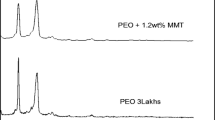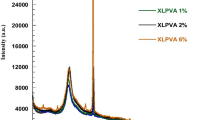Abstract
Oxyethylene macrocyclic compounds (crown-ethers) act as ligands of intracrystalline cations of certain layered silicates as montmorillonites. Stable intercalation materials are formed which are used to prepare organic-inorganic membranes by encapsulating these intercalation compounds with a poly-butadiene thin coating. Electrochemical Impedance Spectroscopy (EIS) is used to study the resulting composite membranes in contact with aqueous electrolytes. From the impedance plots, the ionic resistance of the membranes is obtained. The thickness of the polybutadiene coating is an important factor determining the ability of ions to pass across the membrane. Marked differences in the ionic resistance are observed as a function of the nature of the interlayer macrocyclic compound. For non-intercalated montmorillonite membranes, the ionic resistance is strongly reduced, whereas for some crown-ether intercalated materials such as 18-crown-6 and dibenzo 24-crown-8, iono-selective membranes are obtained. Concerning the nature of the electrolyte, cations exhibiting greater hydration energies show higher difficulties to pass through the membrane and, consequently, the ionic resistance increases.
Similar content being viewed by others
References
McDonald JR (1987) Impedance Spectroscopy, Emphasizing Solid Materials and Systems. John Wiley & Sons Inc New York
Armstrong RD, Covington AK, Evans GP (1983) J Electronanal Chem 159:33
Armstrong RD, Horavai G (1990) Electrochim Acta 35:1
Armstrong RD, Ashassi-Sorkabi H (1987) Electrochim Acta 32:135
Van der Wal PD, Suthölter EJR, Boukamp BA, Bouwmeester HJM, Reinhoudt DN (1991) J Electroanal Chem 317:153
Ruiz-Hitzky E, Casal B (1978) Nature 276:596
Ruiz-Hitzky E, Casal B (1986 In: Setton R (ed) Chemical Reactions in Organic and Inorganic Constrained Systems NATO ASI Series, Series C: Mathematical and Physical Sciences, Vol. 165, Reydel Publish Co Dordrecht p 179
Casal B, Ruiz-Hitzky E (1986) Clay Min 21:1
Casal B, Ruiz-Hitzky E, Van Vaeck L, Adams FC (1988) J Incl Phenom 6:107
Boukamp BA (1989) “Equivalent Circuit (EQUIVCRT.PAS)”, Users Manual, 2nd edition., University of Twente, Report CT89/214/128, Enschede, Holland
Covington AK and Zhou D-M (1992) Electrochim Acta 37:2691
Timothy R, Brumleve R, Buck RP (1978) J Electroanal Chem 90:1
Xie S-L, Camman K (1987) J Electroanal Chem 229:249
Feliu S, Galván JC, Morcillo M (1989) Progress in Organic Coatings, 17:143
Leidheiser H. Jr (1987)J Adhes Sci Technol 1:79
Izzat RM, Bradshaw JS, Nielsen SA, Lamb JD, Christensen JJ (1985) Chem Rev 85:271
Lindquivist SA (1985) corrosion (NACE), 41:69
Strathmann H (1983) “Synthetic Membranes and their Preparation” In: Boungay PM, Londsdale HK, de Pinho MN (eds) Synthetic Membranes: Science, Engineering and Applications, NATO ASI Series D. Reidel Pub Com, Dordrecht 1983
Author information
Authors and Affiliations
Rights and permissions
About this article
Cite this article
Aranda, P., Galván, J.C., Casal, B. et al. Electrochemical characterization of composite membranes based on crown-ethers intercalated into montmorillonite. Colloid Polym Sci 272, 712–720 (1994). https://doi.org/10.1007/BF00659285
Received:
Accepted:
Issue Date:
DOI: https://doi.org/10.1007/BF00659285




